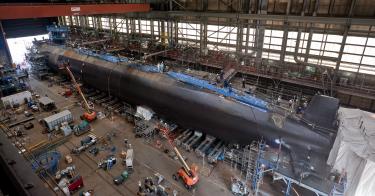With the Navy’s eyes set on achieving a goal well above Congress’ mandated 355 manned warships, the American shipbuilding industry has a lot of work to do. Unfortunately, the industry’s current state doesn’t offer much hope for meeting those goals, let alone sustaining a modestly larger fleet.
In a 2021 report on U.S. defense supply chains, The Heritage Foundation’s Maiya Clark explained what is called a “Fragility and Criticality” assessment. That’s a tool used by the Department of Defense to identify and mitigate weaknesses in the defense industrial base.
Fragility can be understood as how likely disruption is to a certain “product or service,” while criticality indicates how difficult it would be to replace the item.
Applying that tool to U.S. Navy shipbuilding reveals that America is a far cry from its former status as a major shipbuilder.
Let’s briefly examine three metrics:
1) Foreign Dependency
Foreign sources provide the U.S. maritime industrial base with strategic materials critical to constructing vessels, such as precision machine tools, aluminum, and microelectronics. In 2020, China was the third-largest source of microelectronics for the U.S., and in 2021 was the second-largest source of aluminum for the U.S.
Regarding precision machine tools, the theme continues: In 2021, by a wide margin, China topped the charts of machine tools production. It’s concerning that America’s top strategic competitor consistently appears to have a presence in vital supply chains.
2) Too Few U.S. Firms
Since the 1970s, 14 “defense-related shipyards” have shut down, and only one new shipyard has opened. And all the firms still in the shipbuilding sector have dwindled into an oligopoly serving virtually one customer, the U.S. Navy.
To make matters worse, the seven shipyards constructing large and deep-draft ships are only responding to specific ship requirements of the Navy and Coast Guard. As such, shipbuilders are encouraged to service a limited market—exacerbated by the Jones Act, a 100-year-old law intended to ensure the nation has a minimum shipping capacity.
That has distorted the sector into uncompletedness and the death of American shipping. In August, Chief of Naval Operations Adm. Mike Gilday recognized the Navy’s contribution to this slow death of American shipbuilding by not providing any shipbuilding predictability and spoke of the need to give industry a “clear aim point” of needs with a “higher degree of confidence” going forward.
3) Too Few Merchant Marines, Shipyard Workers
Finally, a major challenge of the shipbuilding industry is attracting, training, and retaining skilled labor.
Earlier this year, a manager for a major U.S. shipbuilder emphasized that the labor shortage is the shipbuilding company’s “biggest challenge.” Often, there are not enough workers to replace those who are retiring, and the industry is failing to attract new, young employees.
The Department of Defense recognizes that problem, too. In response to the 2021 National Defense Authorization Act, the Pentagon released a report stating that the shipbuilding “industrial base today lacks the resiliency and bench strength to meet required demand” and stressed the need for long-term, prioritized workforce investments.
The supply of mariners is inadequate, too. If a “sustained crisis” were to occur, the number of required U.S. mariners (whose average age is 46) would fall short by 15%.
For too long, the nation has tried to build the Navy needed while neglecting the fundamentals for building and sustaining it. The result is obvious: namely, too few ships and shipyards unable to meet demand.
To those familiar with Alfred Thayer Mahan’s famous maritime writing, it’s no surprise that without a vibrant competitive shipping and shipbuilding industry, the Navy withers.
To effectively compete with China, the nation needs a larger Navy, and to do so American shipping and shipbuilding must be revived. To do this, America must once again be globally competitive, achieved by leveraging novel technologies that address obvious supply chain weaknesses. Such innovation speaks to American strengths.
Getting there requires using a market bridge; that is, developing revolutionary shipping and shipbuilding to meet urgent military logistic needs with commercial utility. Examples include solving the Navy’s operational challenges with weapons reloading at sea, small modular nuclear reactors for vessel propulsion, and unmanned shipping.
Already, additive manufacturing is being embraced with the Department of Defense’s road map, as well as commercial sectors to alleviate delivery delays, reduce costs, and reduce capital investments for transportation.
And the global delivery drone services market was expected to grow from $2.37 billion in 2021 to $3.49 billion in 2022 and is expected to reach $18.77 billion in 2026. These are just two of several key promising technologies, which if synchronized, can restore American global competitiveness in shipping.
What Impact Will It Have?
Returning to our roots as a maritime nation and asserting the necessary innovations to do so in the modern era will be pivotal to American security and prosperity.
If done well, fostering an American revolution in shipping can energize a lethargic industrial sector critical to the nation’s defense and sustain a wartime economy. As such, a stronger and globally competitive maritime sector serves as a deterrent against Chinese economic coercion and military adventures, which could result in a long war over Taiwan.
This piece originally appeared in The Daily Signal




